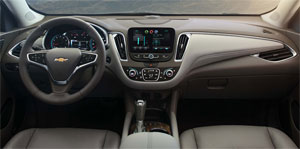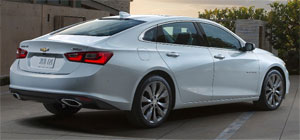2016 Chevrolet Malibu
Honestly, the Chevrolet Malibu has not traditionally been our best choice among midsize family sedans. More rental car necessity than suburban favorite. But the last gen Malibu took major steps to compete more directly with Camry, Accord and others. Now it appears the all-new 2016 Malibu has turned those steps into leaps. So, let’s see if this Chevy stalwart is finally a true family car contender.
Yes the Malibu has struggled, and maybe even been consistently underrated, in the midsize sedan segment. That’s why the 2016 redesign is such an eye opener.
For one thing, it’s a lot bigger, yet still lighter by almost 300-lbs. Wheelbase is now 111.4-inches, up 3½; while overall length increases by about 2-inches.
More importantly, substantial changes are afoot inside. In fact, if you were able to hide the Chevrolet badges, it would be hard to figure out what brand of car it is. It doesn’t look American, none of the switchgear is stock GM; and it certainly doesn’t look Japanese… appears a bit too showy for European… Korean perhaps?
Well that’s a good comparison, as Hyundai and Kia have done a lot over the past few years to step this class up, and it looks like GM is up to the task too.
 Materials improve by a long stride; there are more soft ones, even if it’s still not a consistent feel throughout, there are different surfaces in high wear areas. It’s a good idea, but it could be executed a little better.
Materials improve by a long stride; there are more soft ones, even if it’s still not a consistent feel throughout, there are different surfaces in high wear areas. It’s a good idea, but it could be executed a little better.
And while it may still not match a Honda-level of refinement, the layout and ergonomics are excellent; as they’ve done a good job of leaving proper buttons for the basics, and using touchscreen controls for secondary functions.
There’s even great seat comfort, perhaps the best we’ve felt from GM in recent memory. And they should no longer hear complaints about rear seat legroom, as with all of the additional wheelbase, it’s up by about an inch and a half; though it feels like even more.
On the minus side, all of the rearranging has caused both trunk space and fuel capacity to suffer.
Top drawer Premier trim fulfills all the luxury feature wants you could have in a family car; while available Driver Confidence packages add the latest safety features including automatic braking.
Gauges are fine and clear, and will make convert buyers feel at ease.
 There are 3 engine choices, with all getting some type of assist. A 1.5-liter turbo I4 powers base models, and its 160–horsepower and 184 lb-ft. of torque will probably be adequate for most. It’s attached is a 6-speed automatic.
There are 3 engine choices, with all getting some type of assist. A 1.5-liter turbo I4 powers base models, and its 160–horsepower and 184 lb-ft. of torque will probably be adequate for most. It’s attached is a 6-speed automatic.
Next up, is a 2.0-liter turbo-4 with 250-horsepower and 258 lb-ft. of torque; and it gets a new 8-speed automatic.
Finally, a hybrid returns to the lineup but this time it’s a full-hybrid, based around a 1.8-liter I4 rated at 47 MPG Combined! With both hard and software from the new Volt, and 182 horsepower, it is equally well sorted, and smooth.
We spent most of our time in the 2.0T, and it’s a heck of an engine. Plenty of guts off the line, sharp throttle response, and great torque range for a 4. Transmission shifts are seamless, with programming among the best we’ve driven in an 8-speed yet.
Altogether, the new Malibu is extremely quiet, with virtually all engine and wind noise eliminated; the only real intrusion at this point is a bit too much tire noise on concrete.
Handling is just fine, better than most, as the chassis feels very solid; both suspension and body rigidity are greatly improved, and we found it more responsive than expected.
 GM clearly focused efforts on improving ride and handling, and it shows; even the electric steering has decent weight, although also the typical numb feel.
GM clearly focused efforts on improving ride and handling, and it shows; even the electric steering has decent weight, although also the typical numb feel.
Government Fuel Economy Ratings are up across the board; with the 2.0-liter’s coming in at 22-City, 33-Highway, and 26-Combined……for a good Energy Impact Score of 12.7-barrels of oil consumption and 5.6 tons of CO2 emissions yearly.
As for the all-important pricing, Malibus start at a modest $22,500, with Premier trim coming in at $31,795.
With the growing popularity of SUVs as family mainstays, the four-door sedan market continues to shrink. Yet, it is still large, and with lots of entries, making it a true buyer’s market. The 2016 Chevrolet Malibu has now jumped into the sweet spot of that fray. The turbo-4 gives it a sportier feel over a traditional V6, and comfort is top notch. Plus, the Hybrid gives the most fuel conscience a serious new choice. While no car design is perfect, overall, this Malibu makeover has us very impressed.
Specifications
- Engine: 2.0 liter
- Horsepower: 250
- Torque: 258 lb-ft.
- EPA: 22 mpg city/ 33 mpg highway
- Energy Impact: 12.7 barrels of oil/yr
- CO2 Emissions: 5.6 tons/yr
2024 Toyota Land Cruiser
Toyota’s Go Anywhere Globetrotter Returns To U.S.
Every once in a while, we all need a reset. A time to get back to basics and prioritize the things that really matter. Well, for the Toyota Land Cruiser that time is now. So, let’s find out if that means bigger and better things for Toyota’s iconic off-roader.
The Toyota Land Cruiser’s status among the global off-road community is legendary, and it’s hard to imagine there’s any corner of the earth where a Land Cruiser hasn’t kicked up a little dust or mud. Well, 2024 sees the return of the Land Cruiser to the U.S. market after a 3-year hiatus, getting a major reset for the journey.
The reset comes mostly by no longer being based on the large three-row “300-series” chassis, but a new version of the smaller “200-series,” now known as the J250. As with the latest Tacoma, it uses the Tundra pickup’s full-size steel frame.
While the main Land Cruiser model, which goes by simply Land Cruiser, is packed full of luxury and convenience features, there is also a stripped-down model known as the 1958, honoring the first year the Land Cruiser made landfall here in North America. And it is that 1958 we have here, and we were glad to see it, as it also celebrates the original’s back-to-basics approach as a blank canvas for you to personalize as you tackle more and more adventures.
Not that it’s fully stripped down, as 8-inch touchscreen infotainment, a 7-inch full-color multi-information display, and automatic climate control are still standard. Plus, some seriously durable materials, and great heated cloth front seats that throw off some get serious 1990s Tacoma vibes.
But outside, there’s a definite lack of flashy trim and basic looking 18-inch wheels with Yokohama Geolander all-season tires; plus, big chunky bumpers and tilt-up back glass, which is a rarity that we appreciate. Though there is a little too much plastic in places that are sure to see some abuse if you do any significant off-roading.
It even feels a little rough around the edges, but for us it just adds to the rugged old-school utility vibe in a good way.
We did just that, both here in the Mid-Atlantic as well as in the California desert; and while there are some tech-forward driving aids, the actual hardware is in most cases plenty to get things done. That includes standard full-time dual-range four-wheel-drive, locking center and rear diffs, and 8.7-inches of ground clearance. A front stabilizer bar disconnect is also available to allow for increased articulation.
Who needs a V6 or even a V8 when you’ve got Toyota’s i-FORCE MAX setup at your disposal with 326 horsepower and 465 lb-ft of torque coming from a 2.4-liter turbo-four with an electric motor sandwiched between the engine and its eight-speed automatic transmission. Low speed torque delivery is impressive. It even feels a little rough around the edges, which may be a turn off to some, but for us it just adds to the rugged old-school utility vibe in a good way.
And it certainly feels quicker than an off roader needs to be, with an instant torque dump as soon as we eased on the throttle at our Mason Dixon test track; helping us get to 60 in 8.1 seconds and through the quarter-mile in 16.3 seconds at 86 mph. Considering the Land Cruiser’s terrain conquering mission, it behaved quite well in our handling course; it was plenty responsive to inputs, with less body roll than we expected and plenty of grip from the tires. The steering was light and quick but as expected didn’t provide much feel. Other than significant nosedive, braking performance was exceptional. Only 107-feet to panic stop us from 60 mph.
With the shift to the smaller size, there’s no more third row available, and cargo capacity now comes in at 46.2 cubic-feet with a max of a still healthy 82.1. Now, the best part of the Land Cruiser’s return is the entry price of $57,445. That’s about 30-grand less than what the last Land Cruiser went for back in 2021.
Whether it’s over the top fashion trends, mullets, or zombies; just when you think they’re dead, they come roaring back to life. Of course, we’re much happier to see the resurrection of this 2024 Toyota Land Cruiser than any of those things. Toyota is one brand that still recognizes the value of full-framed rugged rigs and has also acknowledged that sometimes less really is more. The Godfather of Toyota off-roading is back and better than ever.







